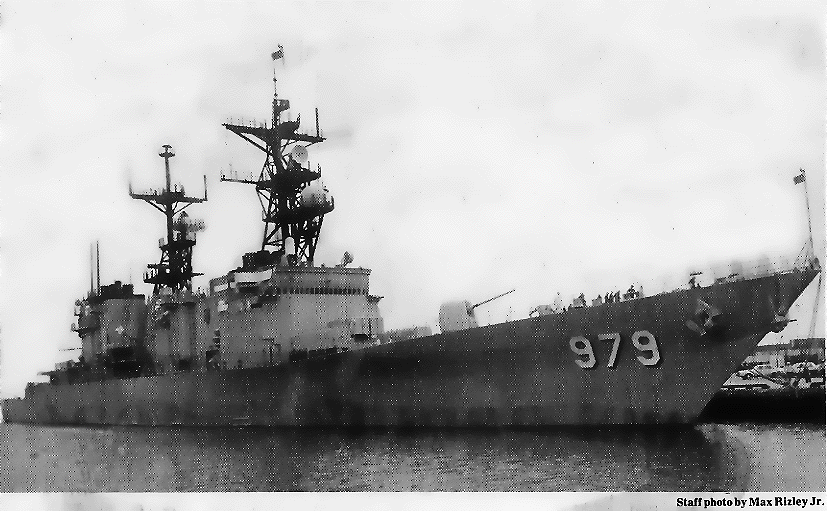
Too risky, he says. Somebody might get hurt. After all, look what happened to Challenger.
I'm pondering this just now, as I cling for dear life to a rope ladder swaying precariously above a squall-churned Gulf of Mexico, halfway between a destroyer's quarterdeck and the beckoning arms of Davy Jones.
Risky? I think, as the sea tries to shake me from my perch like a ripe apple from a tree. John, you ride with me some day and we'll talk about "risky... "
... It all started with a phone call from the Navy. The destroyer Conolly was to arrive in Galveston the next day, and if I could get to Pier 15 by 9 a.m., I could ride out on the media boat to meet her.
The plan, as I understood it, was to board the media boat (supplied by the Coast Guard; no doubt it would be the admiral's personal yacht, at least a hundred-footer, well-stocked with champagne and caviar on toast points) and meet the Conolly at the channel entrance buoy. We'd follow her in, leisurely snapping dramatic underway photos while liveried stewards made sure our glasses were never empty.
At the pier the next day, though, there was no sign of a yacht at 9 a.m. All there was, was a voice, calling, "Hey, do you all want us to pull in a little closer or can you jump from there?"
I looked up, left and right for the voice, then peered gingerly over the edge of the pier.
Down, 'way down, on the water, was a battered 42-foot Coast Guard utility boat, barely big enough for its crew of three, looking like a forlorn toy bobbing amid the dead mullet and discarded Big Mac boxes.
Fifteen minutes later found three press, three Navy public-affairs officers in dress whites, and three Coast Guardsmen all wishing they'd stayed in bed. The little cockleshell of a boat was wallowing seaward through a sudden and fierce squall, groaning up the back of one grey-bearded swell after another and pancaking down into the troughs with a molar-rattling thud!
"Ohhhhhhhhhhhh," the press corps moaned after each impact.
Finally, the moment we had all been awaiting was nigh. "There she is," our Navy chaperone beamed, pointing at a gray blob quavering uncertainly on the horizon. "The Conolly."
"Thud!" said the media boat. "Unnnhhhhhhh," groaned the press.
Eventually, the blob resolved itself into a ship, and a handsome one, at that. She was stirring in the way only a dressed-out Navy ship can be stirring: a rainbow of signal flags snapping in the gale, white-hatted sailors manning the rails, and Old Glory waving prominently at her stern. The sight brought some color back to even the greenest faces on the media boat.
Half a minute later, the Navy PAO looked up from her radio. "If any of you want to board the Conolly and ride her in, they'll slow down to eight knots and put a ladder over the side."
As she spoke, the little boat pulled to within arm's length of the 563-foot destroyer, which at that distance was more like a mountain range than a ship, a sheer, gray massif off the port beam. Our own Coast Guard skipper added to the illusion by matching the press boat's speed so skillfully with the Conolly's that the great grey hulk seemed as firmly-rooted as a continent; the thin ribbon of sea between the vessels appeared, startlingly, to be rushing past like a mountain river until I remembered it was the ships and not the water that was moving.
From up in the clouds somewhere, an unseen hand lowered a Jacob's ladder -- two lengths of rope joined by safety-orange plastic rungs; obviously, the Navy hadn't yet gotten around to putting escalators in its ships.
"Okay, who's going?" asked our Navy escort, as the dangling end of the ladder danced a merry hornpipe two feet above the waves.
Now was the moment of truth. We could climb a rope ladder three miles up to the Conolly's rock-steady quarterdeck, and risk death or mere disgrace, depending on whether we fell into the yawning chasm between the two ships or froze halfway up and had to be pried free with power tools after the destroyer was docked.
Or we could stay on the media boat for another hour.
Every hand went up ...
... Harbor pilots do this all the time, I reassure myself, as I pick my way along the media boat's heaving deck to the jumping-off point. You just wait for the heave to bottom out, then grab the rope and plant your sneakers on the bottom rung. Don't look up, don't look down, don't look sideways. Focus only on the blank gray square of hull right in front of your eyes; it reduces the situation to an emotionally manageable scale. It's a stairway to Heaven, but you only need to worry about it a step at a time. Easy, huh?
But you're not a harbor pilot, a taunting little voice sneers inside my head as the Jacob's ladder sways gently out, my gray world receding momentarily as Conolly answers a broaching swell. I grit my teeth and seek the next rung, and the next.
"Here, give me your hand." What? I'm at the top? Already? You mean, I made it? What a pleasant surprise.
I want to flop gasping onto Conolly's deck like a gaffed tuna; instead, I step off the ladder, nod a jaunty "good morning!" to the seamen gathered on the quarterdeck, and fall in with the one detailed to show the press up to the bridge. Appearances, you know.
So John, if you read this, come on down next time the Navy brings a ship in here, and hop on the media boat with me. Then tell me again about taking risks.